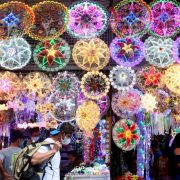Digitizing urban forest management
Jakarta attracted much attention from national and international mass media three months ago—not because of impressive urban development but due to its worsening air pollution which, according to health ministry officials, caused widespread respiratory illness. The health minister even confirmed that President Joko “Jokowi” Widodo had to battle a cough for weeks. CNN quoted the report of IQAir, a Swiss air quality technology company, in August that Jakarta’s air quality had deteriorated to become one of the worst in the world. The pollution was blamed on excessive road traffic, the long dry season, and energy sources—mainly coal-fired power generation plants around Jakarta.During the COVID-19 pandemic from 2020 to 2022, people donned masks when entering buildings, but now many people wear masks when they are outdoors mostly because of air pollution. This not only affects the quality of life of the urban people but is also a major factor in the health-care cost of air pollution and heat-related diseases such as acute respiratory illness.
The government development of a new national capital in East Kalimantan to replace Jakarta within the next five to 10 years may reduce air pollution only temporarily. This new city also will eventually suffer from air pollution if right from the outset the city administration does not put in place the only infrastructure that can reduce city air pollution at a large scale without stopping the traffic and the energy production: trees, the urban forest!—and necessitated by the large scale digitized management of these urban forests.
The health hazards cited above further validate the urgent need for large cities, such as Jakarta with a population of over 10 million, to better manage its urban forests because climate change has put the urban environment under more stress.
Cities around the world are already implementing large-scale tree planting programs from Berlin and Budapest to Denton, San Francisco, and Melbourne and many more.But the prime example is much closer to Jakarta: Singapore with 5.9 million residents has decided to plant an additional one million trees in the near term (half of that is already done). That is increasing the number of trees under the management of the National Parks Board from three to four million. A 33-percent increase in capacity while also improving the quality and accuracy of tree-care and information: This is only possible with digitalization.Scientific studies show that cities should have a minimum 30 percent of canopy cover in climate adaptation for the protection of their citizens: most benefits come from the canopies, and specifically the leaves. The bigger the canopy, the larger the total leaf area of the tree, the more shading, and more evaporation of water to reduce temperature, more PM2.5 dust and unhealthy chemicals (nitrogen dioxide, sulfur dioxide, ozone, carbon monoxide, etc.) captured by the leaves, and more carbon dioxide converted back to oxygen by the chlorophyll in those leaves.
Overcrowded cities need to cope with the adverse impact of the increasing climate stress: on people and trees alike. The green (biological) infrastructure needs support and management to be safe and to deliver increasingly better performance. To make the management of urban forests more efficient and well-targeted, we need to transform the traditional manual methods with a smart, data-based digital management of this green infrastructure to accommodate the increasing urbanization.
With the recent major leaps in remote sensing technologies, artificial intelligence (AI), and machine learning, it became possible to automate the data collection, mapping, measurement, and analysis producing immediately actionable intelligence about the urban green landscape for both the operation and maintenance as well as the optimization of the future developments and improvements.Digitizing urban forests enables cities to enhance the ecological and economic benefits of their urban trees and the well-being of their citizens. A digital platform with a combination of AI and machine learning can make a very efficient tree inventory to track the location, species, and condition and identify trees that are at risk of falling, disease, or otherwise hazardous.
Put another way, a smart tree inventory platform will improve public safety by helping cities to identify and remove hazardous trees before they can cause injury or damage, reduce costs by optimizing their tree maintenance, increase tree canopy cover by helping cities to plant and maintain more trees, thereby improving air quality, reducing the noise level, and increasing energy saving.
Let us all work together to make our future cities more livable for our children despite the increasing climate change.
The Jakarta Post/Asia News Network
Peter Sasi is president of CEE Chamber of Commerce (Singapore), board of directors Eurocham, and vice president of greehill technology company for Asia-Pacific. The views expressed are his own.
The Philippine Daily Inquirer is a member of the Asia News Network, an alliance of 22 media titles in the region.
















